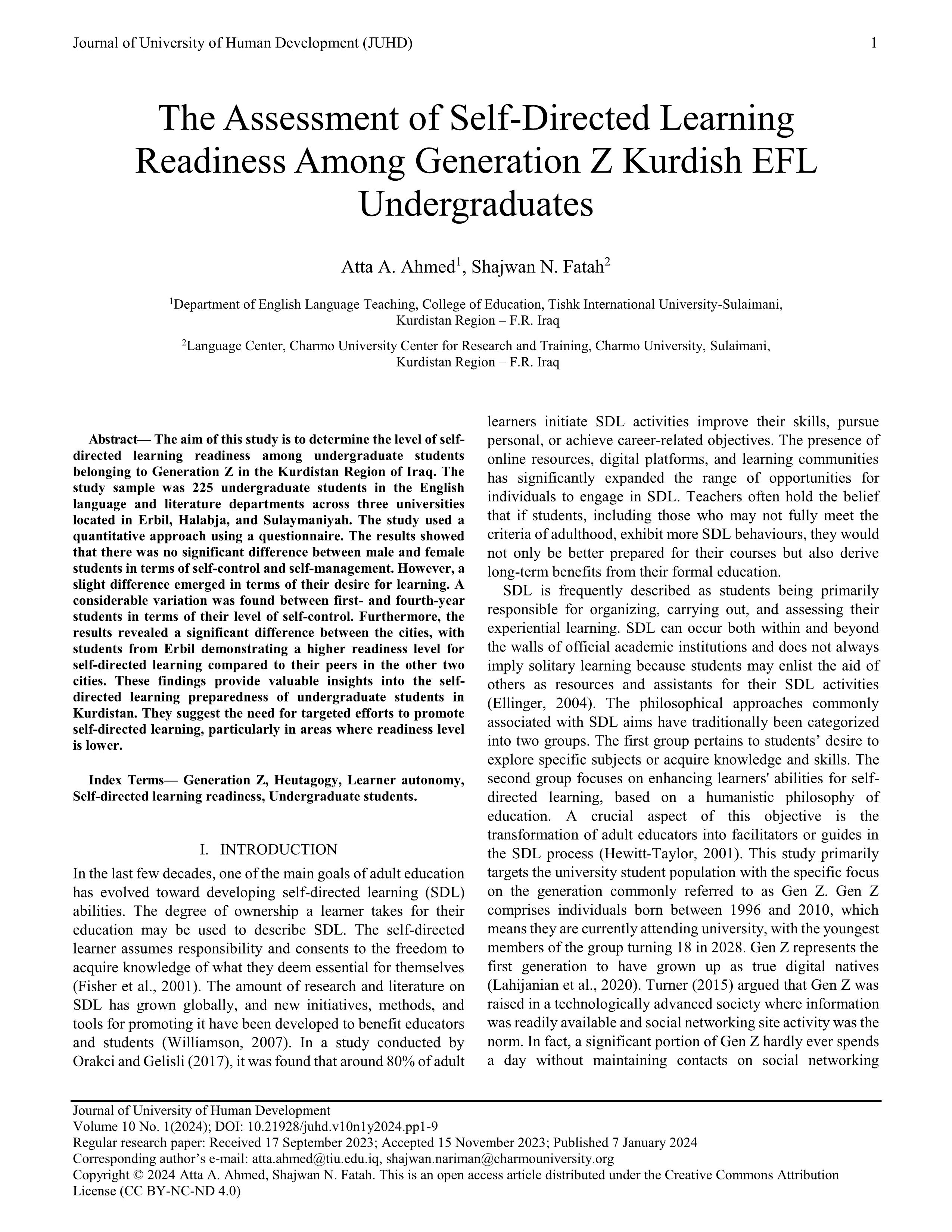The Assessment of Self-Directed Learning Readiness Among Generation Z Kurdish EFL Undergraduates
DOI:
https://doi.org/10.21928/juhd.v10n1y2024.pp1-9Keywords:
Generation Z, Heutagogy, Learner autonomy, Self-directed learning readiness, Undergraduate studentsAbstract
The aim of this study is to determine the level of self-directed learning readiness among undergraduate students belonging to Generation Z in the Kurdistan Region of Iraq. The study sample was 225 undergraduate students in the English language and literature departments across three universities located in Erbil, Halabja, and Sulaymaniyah. The study used a quantitative approach using a questionnaire. The results showed that there was no significant difference between male and female students in terms of self-control and self-management. However, a slight difference emerged in terms of their desire for learning. A considerable variation was found between first- and fourth-year students in terms of their level of self-control. Furthermore, the results revealed a significant difference between the cities, with students from Erbil demonstrating a higher readiness level for self-directed learning compared to their peers in the other two cities. These findings provide valuable insights into the self-directed learning preparedness of undergraduate students in Kurdistan. They suggest the need for targeted efforts to promote self-directed learning, particularly in areas where readiness level is lower.
References
Ahmed, A. A., Jafr, M. M., Saeed, M. A. H., Ali, A. O., Mahmood, B. F., Muhammad, S. N., & Abdullah, S. A. (2022). The Impact of Social Media on the Interaction Between Students and Teachers at the University of Halabja. Journal of Philology and Educational Sciences, 1(1), 27-37. doi.org/10.53898/jpes2022113
Anderson, M., & Jiang, J. (2018). Teens, social media & technology 2018. Pew Research Center, 31(2018), 1673-1689.
Benson, P., & Voller, P. (2014). Autonomy and independence in language learning. Routledge.
Bonett, D. G., & Wright, T. A. (2015). Cronbach's alpha reliability: Interval estimation, hypothesis testing, and sample size planning. Journal of organizational behavior, 36(1), 3-15.
Boyadzhieva, E. (2016). Learner-centered teaching and learner autonomy. Procedia-Social Behavioral Sciences, 232, 35-40. doi.org/10.1016/j.sbspro.2016.10.008
Chen, H., & Volpe, R. P. (2002). Gender differences in personal financial literacy among college students. Financial services review, 11(3), 289-307.
Clifford, V. A. (1999). The development of autonomous learners in a university setting. Higher Education Research & Development, 18(1), 115-128.
Douglass, C., Morris, S. R., & Learning. (2014). Student perspectives on self-directed learning. Journal of the Scholarship of Teaching and Learning, 13-25. 13-25. doi.org/10.14434/josotl.v14i1.3202
Ellinger, A. D. (2004). The concept of self-directed learning and its implications for human resource development. Advances in developing human resources, 6(2), 158-177. doi.org/10.1177/1523422304263327
Fisher, M., King, J., & Tague, G. (2001). Development of a self-directed learning readiness scale for nursing education. Nurse Education Today, 21(7), 516-525. doi: 10.1054/nedt.2001.0589
Frankel, J., & Wallen, N. (2009). How to Design and Evaluate Research in Education. New York: McGraw-Hill.
Gharti, L. (2019). Self-directed learning for learner autonomy: Teachers' and Students' perceptions. Journal of NELTA Gandaki, 1, 62-73. doi.org/10.3126/jong.v1i0.24461
Grow, G. O. (1991). Teaching learners to be self-directed. Adult education quarterly, 41(3), 125-149. doi.org/10.1177/0001848191041003001
Hase, S. (2009). Heutagogy and e-learning in the workplace: Some challenges and opportunities. Impact: journal of applied research in workplace e-learning, 1(1), 43-52. doi:10.5043/impact.13
Hase, S., & Kenyon, C. (2000). From andragogy to heutagogy. UltiBASE In-Site.
Hewitt‐Taylor, J. (2001). Self‐directed learning: views of teachers and students. Journal of advanced nursing, 36(4), 496-504. doi.org/10.1046/j.1365-2648.2001.02001.x
Knowles, M. S. (1980). The Modern Practice of Adult Education from Pedagogy to Andragogy. New York: The Adult Education Company. Cambridge
Lahijanian, B., Basinger, K., Karaca, M., Alvarado, D., Buzard, B., & Alvarado, M. (2020). Flipped classroom video engagement for generation Z engineering students. In Proceedings of the 2020 IISE Annual Conference and Expo (pp. 1-6). Institute of Industrial and Systems Engineering.
Little, D. (2003). Learner autonomy and second/foreign language learning. Guide to Good Practice.
Littlemore, J. (2001). Learner autonomy, self-instruction and new technologies in language. ICT and language learning: A European perspective, 1, 39.
Loeng, S. (2020). Self-directed learning: A core concept in adult education. Education Research International, 2020, 1-12. doi.org/10.1155/2020/3816132
Miltiadou, M., & Savenye, W. C. (2003). Applying social cognitive constructs of motivation to enhance student success in online distance education. International Review of Research in Open and Distance Learning, 4(2). doi: 10.19173/irrodl.v4i2.126
Moore, R. L. (2020). Developing lifelong learning with heutagogy: contexts, critiques, and challenges. Distance Education, 41(3), 381-401. doi.org/10.1080/01587919.2020.1766949
O'Kell, S. (1988). A study of the relationships between learning style, readiness for self-directed learning and teaching preference of learner nurses in one health district. Nurse Education Today, 8(4), 197-204. doi.org/10.1016/0260-6917(88)90149-9
Orakci, S., & Gelisli, Y. (2017). Learner autonomy scale: A scale development study. Malaysian Online Journal of Educational Sciences, 5(4), 25-35.
Razali, A. B., Xuan, L. Y., & Abd. Samad, A. (2018). Self-Directed Learning Readiness (SDLR) among Foundation Students from High and Low Proficiency Levels to Learn English Language. Malaysian Journal of Learning and Instruction, 15(2), 55–81. https://doi.org/10.32890/mjli2018.15.2.3
Tarhan, B., & Erözden, A. (2008). Learner Autonomy and Trainee Teachers’ Readiness for Self-Directed Learning. Boğaziçi Üniversitesi Eğitim Dergisi, 25(1), 43-63.
Tekkol, İ. A., & Demirel, M. (2018). An investigation of self-directed learning skills of undergraduate students. Frontiers in psychology, 1-14. doi.org/10.3389/fpsyg.2018.02324
Turner, A. (2015). Generation Z: Technology and social interest. The Journal of Individual Psychology, 71(2), 103-113.
Wichadee, S. (2011). Developing the self-directed learning instructional model to enhance English reading ability and self-directed learning of undergraduate students. Journal of College Teaching & Learning (TLC), 8(12), 43-52. doi.org/10.19030/tlc.v8i12.6620
Wiley, K. (1983). Effects of a self-directed learning project and preference for structure on self-directed learning readiness. Nursing Research, 32(3), 181-185.
Williamson, S. N. (2007). Development of a self-rating scale of self-directed learning. Nurse researcher, 14(2). doi: 10.7748/nr2007.01.14.2.66.c6022

Downloads
Published
How to Cite
Issue
Section
License
Copyright (c) 2024 Atta A. Ahmed, Shajwan N. Fatah

This work is licensed under a Creative Commons Attribution-NonCommercial-NoDerivatives 4.0 International License.


